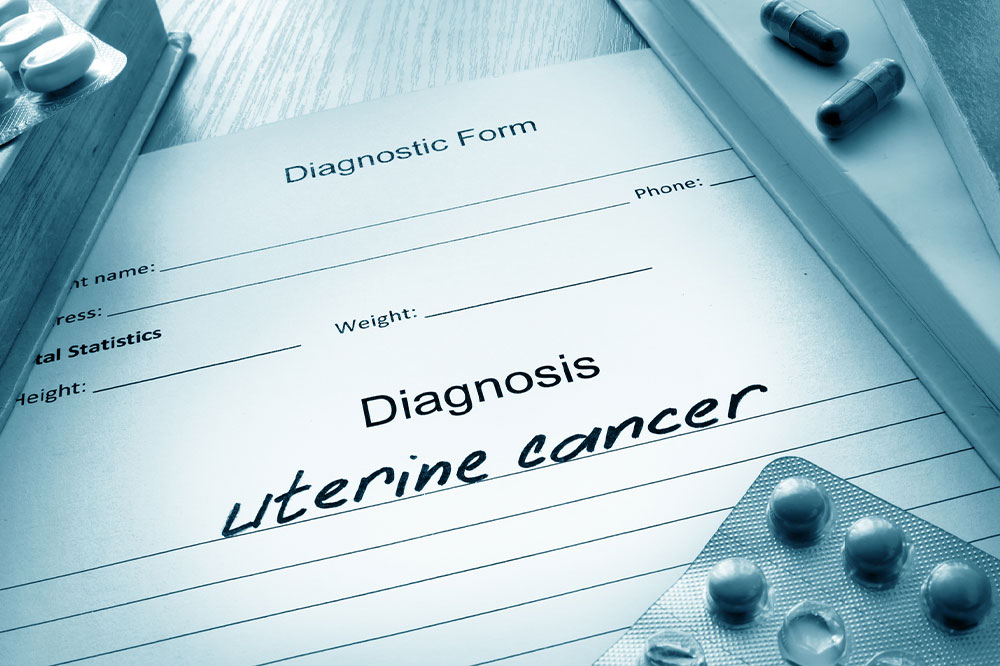Uterine Cancer – Its Causes, Symptoms, and Stages
Uterine cancer, a type of cancer that begins in the lining of the uterus, is associated with signs like lower abdomen pain, pelvic discomfort, and abnormal bleeding in women. In 2020, an estimated 97,370 people across the world succumbed to uterine cancer. The five-year survival rate for uterine cancer patients is 81% in the country. Read on to know the signs and symptoms and treatment options for uterine cancer.
Causes of uterine cancer
While there isn’t any specific cause of uterine cancer, there are potential risk factors that one needs to steer clear of.

Types of uterine cancer
There are two types of uterine cancer:
Endometrial cancer
This is a more common type of cancer that develops in the lining of the uterus. It’s one of the most common gynecologic cancers affecting the reproductive system.
Uterine sarcoma
This is a rare type of uterine cancer that develops in the myometrium, the muscle wall of the uterus.
Uterine cancer signs and symptoms
The signs and symptoms help diagnose where the problem in the body lies. Make a note of changes in symptoms and frequency to explain them to the doctor. Examining the discomfort, pain, swelling, and change in blood pressure can help the expert get closer to the issue.
Below listed are common signs and symptoms of uterine cancer:
Bleeding between periods
Spotting or bleeding after menopause
Lower abdominal pain or cramps in the pelvis area
White, clear vaginal discharge
Heavy bleeding or frequent bleeding after 40
Watery or streaked flow or heavy blood flow
Making note of these symptoms and talking to a doctor is important, as the issue can be diagnosed at an early stage, helping one manage the symptoms of cancer and minimizing the damage caused by it. Cancer, when diagnosed at an initial stage, can be prevented from spreading to other parts of the body. Also, chances are cancer cells will be eliminated from the body, and a uterine cancer patient can be cured.
Stages of uterine cancer
Like other cancer illnesses, uterine cancer is also categorized into stages to understand the advancement of the illness. Knowing the stage of cancer plays a key role in deciding the course of treatment to effectively manage the symptoms and relieve the discomfort associated with the illness.
Stage 1 – Cancer cells are limited to the uterus
Stage 2 – Cancer spreads to the cervix
Stage 3 – Cancer spreads to the nearby lymph nodes, ovaries, fallopian tubes, or the vagina
Stage 4 – Cancer spreads to the bladder, rectum, abdomen, or even lungs
Uterine cancer treatments
There are various approaches to treat uterine cancer, including varied surgeries and therapies.
Surgical approaches:
Abdominal hysterectomy
This procedure involves surgical removal of the uterus and cervix through the abdomen.
Minimally invasive hysterectomy
This procedure involves the removal of the uterus, cervix, fallopian tubes, and ovaries through the vagina. Removal of the fallopian tubes and ovaries (bilateral salpingo-oophorectomy) is also recommended.
Radical hysterectomy
If cancer has spread to the cervix, the doctor may recommend this procedure. The surgeon removes the uterus and the tissues around it. Additionally, the surgeon may remove the upper portion of the vagina that touches the cervix.
Other procedures that may or may not combine surgery include:
Radiation therapy
Radiation in a set schedule may be prescribed for a uterine cancer patient. This procedure sends out high-energy x-rays that help destroy cancer cells. Radiation therapy may be administered externally or internally.
Chemotherapy
This therapy is prescribed to combat cancer cells and keep them from developing inside the body. Chemotherapy may be followed after performing surgery, and it will also have a schedule or a specific number of cycles. The idea is to kill the remaining cancer cells after surgery and keep the tumor from growing.
Hormone therapy
The procedure involves using progesterone and administering the hormone orally to help slow down the development of cancer cells. This therapy may also be prescribed to those who cannot undergo surgery or radiation therapy.
Immunotherapy
Doctors prescribe this treatment option to help the immune system identify and kill abnormally growing cancer cells. This is an effective way to help improve the immune system and combat cancer symptoms.
Preventative measures for uterine cancer
Watch out for signs
If one or two family members are diagnosed with bladder, pelvic, or other types of cancer, it would be wise to run tests to diagnose cancer at an early age. Women in their 40s should especially keep an eye out for signs.
Adapt an active lifestyle
Indulge in an evening stroll, go running, or cycle to work or a grocery store to make sure one gets a decent workout for the day. An active lifestyle helps eradicate the possibility of many illnesses.
Eat well
Make a conscious choice in the meal plans. Opt for freshly cooked meals over frozen dinners and canned food options. Ditch the sweet sodas and packaged juices, flavored yogurt, and sugary treats.
De-stress
It’s essential to indulge in activities that help one unwind and de-stress in the best way possible. Stress plays a major role in causing illnesses and should be addressed. Make choices to enjoy life by spending more time with family and allowing oneself to go on vacations.




